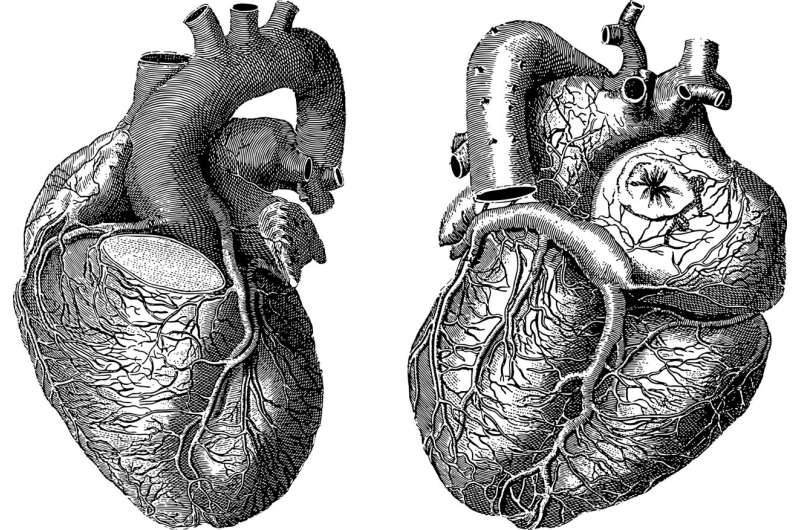This article has been reviewed according to Science X's editorial process and policies. Editors have highlighted the following attributes while ensuring the content's credibility:
fact-checked
peer-reviewed publication
trusted source
proofread
Repurposed drug shows promise for treating cardiac arrhythmias

Ruxolitinib, a drug that is already approved by the U.S. Food and Drug Administration (FDA) for treating certain cancers and skin conditions, is effective at inhibiting CaMKII, a protein kinase linked to cardiac arrhythmias.
In a new study published June 21, 2023, in Science Translational Medicine, researchers from Johns Hopkins University and the University of Chicago invented a new reporting technique to monitor activity of CaMKII while screening the effects of nearly 5,000 FDA approved drugs on human cells that expressed the enzyme. The screen identified five previously unknown CaMKII inhibitors; ruxolitinib, which is used to treat cancers of the blood and bone marrow, along with skin conditions like atopic dermatitis and vitiligo, was the most effective.
CaMKII, or Calcium and calmodulin-dependent protein kinase II, is critical to cardiomyocytes, the muscle cells of the heart, where it maintains the balance of calcium. Activation of CaMKII helps facilitate rapid changes in heart activity, such as initiating a fight-or-flight response in the body. Overactivation can lead to impaired heart function and cell death, which can in turn lead to poor heart health outcomes like arrhythmia.
CaMKII is perhaps best known, however, for its role in the brain, where it is believed to play key roles in learning and memory. This has slowed the development of CaMKII inhibitors to treat arrythmia, for fear they could impact cognitive function.
"Finding an FDA approved drug means that millions of people have been taking CaMKII inhibitors, and in the case of ruxolitinib, there are no reported major problems with the brain," said Mark Anderson, MD, Ph.D., a senior author of the paper and Dean of the Biological Sciences Division and Pritzker School of Medicine, Executive Vice President for Medical Affairs, and Paul and Allene Russell Professor at the University of Chicago. "That should give pharma and biotech companies confidence that they could carry out development of a CaMKII inhibitor program, because the biggest obstacle seems to be surmountable."
The research began in Anderson's lab at Johns Hopkins University, where he previously served as the William Osler Professor and Director of the Department of Medicine. Oscar Reyes Gaido, the study's first author and an MD-Ph.D. student in the lab, developed a new tool to measure activity of CaMKII in living cells. He started with a protein called green fluorescent protein (GFP), originally derived from jellyfish, that emits green light. He then engineered the GFP tag to detect CaMKII activation, making a new reporter called CaMKAR (CaMKII Activity Reporter). When this reporter was inserted into human heart cells, it helpfully glowed bright green whenever CaMKII became active, allowing researchers to monitor enzyme activity.
"This biosensor will be very useful for studying how CaMKII activity changes in both healthy and pathological contexts. Existing methods can measure CaMKII activity, but they lack the versatility and resolution to track in real time and with high sensitivity," Reyes Gaido said. "This has been a real obstacle for studying enzyme biology in general, so this gives the field an important new tool."
Using this tool, the researchers conducted a drug repurposing screen to test the effects of 4,475 approved compounds on cultured human cardiomyocytes. This identified five previously unknown CaMKII inhibitors: ruxolitinib, baricitinib, silmitasertib, crenolanib, and abemaciclib. Of the five, ruxolitinib was the most effective at inhibiting CaMKII activity in cell and mouse models of CaMKII-driven arrhythmias. A 10-minute application of the drug was enough to prevent catecholaminergic polymorphic ventricular tachycardia (CPVT), a congenital source of pediatric cardiac arrest, and rescue atrial fibrillation, the most common clinical arrhythmia. Crucially, the mice treated with ruxolitinib did not show any adverse cognitive effects when they were tested with memory and learning tasks.
Anderson said that new drugs based on ruxolitinib could be used in several ways to treat heart conditions. One would be what he called the "pill in a pocket" scenario. In the early stages of atrial fibrillation, people could take the medication occasionally as symptoms arise. Patients with CPVT are often resistant to standard treatments, and a ruxolitinib-based treatment could provide another option. Finally, there is evidence that inhibiting CaMKII during a heart attack can prevent heart muscle from dying, so emergency responders could potentially administer such a drug as part of standard practice.
"There's been a long search for fundamental pathways that could be targets for therapeutics in arrhythmias," Anderson said. "This could be a finding that will translate relatively rapidly into people now since it's already been proven to be safe in humans."
More information: Oscar Reyes Gaido et al, An Improved Reporter Identifies Ruxolitinib as a Potent and Cardioprotective CaMKII Inhibitor, Science Translational Medicine (2023). DOI: 10.1126/scitranslmed.abq7839. www.science.org/doi/10.1126/scitranslmed.abq7839


















